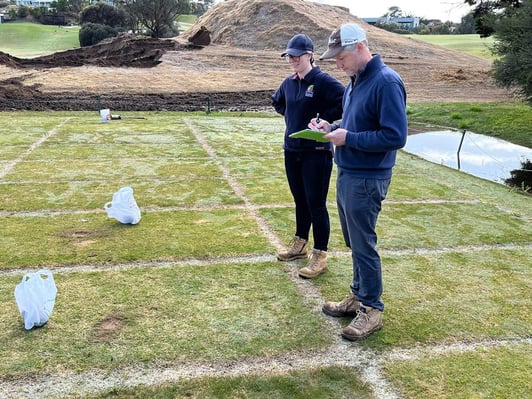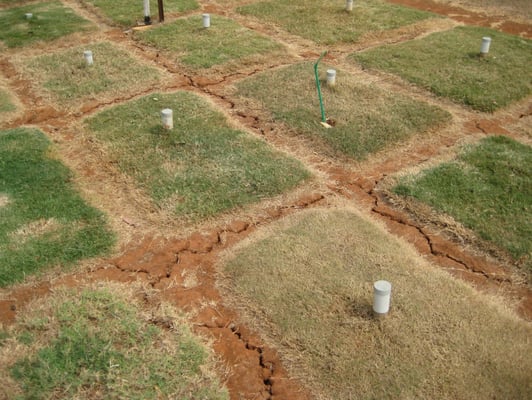The impacts of a changing climate on turfgrass management will be varied and highly localised. It will be up to turf managers to understand their turf areas, identify potential vulnerabilities, and plan for the potential impacts. This will involve not only changes in turf management but also changes in expectations during high-stress periods. It must be noted that climate change is not uniform, and there will be localities that are either less or more affected or possibly not at all due to modifying influences such as aspect, altitude and proximity to the sea.
Table 1 outlines the potential impacts of a changing climate and the possible adaptation techniques that may need to be employed.
Table 1: Potential impacts of a changing climate and adaptation techniques
|
Climate impact |
Turf effect |
Adaption process |
|
More frequent and hotter hot days. |
|
|
|
Fewer frost days. |
|
|
|
Weather systems are projected to shift south in winter. |
|
|
|
Cool-season rainfall is projected to decline in southern Australia. |
|
|
|
Extreme rain events are more intense. |
|
|
|
Time in drought is projected to increase in southern Australia. |
|
|
|
Lower relative humidity and higher evaporation rates. |
|
As above. |
|
Soil moisture is projected to decrease, and future runoff will decrease where rainfall is projected to decrease. |
As per effects of drought and increased evaporation. |
As above. |
|
Rainfall changes and rising humidity and temperatures. |
|
|
|
Higher temperatures will increase the range and incidence of many pests and diseases. |
|
|
What are climate change's impacts on temperatures?
Each turfgrass species has a specific temperature range characterized by an upper and lower threshold and an optimum temperature (Beard, 1973). In general, increases in temperature caused by climate change will affect plant phenology[1] and growth, with increasing temperatures speeding the rate of phenological development (Hatfield, 2017). Increasing temperatures will result in:
- Greater direct stress on the plant.
- Increased damage to turf roots.
- Increased incidence of diseases and insects.
- Greater overnight temperatures which will reduce turf cooling and increase the incidence of disease.
- Greater direct stress on the plant.
What are climate change's impacts on water availability and quality?
The maintenance of high-quality turf relies on having access to a constant water supply that is of moderate to high quality. The time is approaching when high-quality potable (drinking) water will not be available for irrigating turf areas, and lower-quality water, potentially higher in salts and other contaminants, will have to be used. The stress on the available water supply is driven principally by population growth and is being exacerbated by climate effects.
A warming climate will increase evaporation and increase the irrigation demand. In the long term, to be ecologically and economically sustainable, turf managers will have to:
- Make do with lower-quality water sources.
- Treat the water and soils to offset the detrimental effects of salts, bicarbonates and nutrients.
- Introduce more water-efficient and salt-tolerant turfgrass species.
- Employ improved irrigation practices.
What are climate change's impacts on grass species and plant breeding?
Climate change has brought a sharp focus on plant breeding programs to develop cultivars with improved performance in dry environments. In the future, turfgrasses will have to survive with less water of poorer quality.
In Australia, with the predominance of warm-season grasses and in particular Couch grass, it could be argued that there is minimal scope for improving it in terms of drought and salinity tolerance.
Lambrides et al. (2013) collected and screened over 1000 Couch grass ecotypes to develop water and nutrient-use-efficient bermudagrass cultivars. Based on this collection, it was demonstrated that there were Couch grasses with superior drought resistance (Zhou et.al. 2014) and improved salinity tolerance (Tran et. al. 2012).
Zoysiagrass is a grass that is receiving a lot of attention because of its low water use, drought tolerance, shade tolerance and ability to survive severe winter conditions. In the US in particular, Zoysiagrass is seen as a good replacement for traditional cool-season fairways and lawns where reduced water use and summer hardiness is required while also being tolerant of severe winters. There has been limited use of Zoysiagrass in Australia, and more research is required to determine where it fits in the Australian turfgrass environment.
Recent flooding events along the eastern seaboard of Australia have raised the issue of how tolerant turfgrasses are of inundation and the associated silt deposits. Based on limited research and observation, Couch grass has demonstrated a high level of tolerance to flooding, but more research is required.
What are climate change's impacts on turf management?
In addition to the impact that climate change will have on the available water supply, there is the potential for changes in the distribution of existing pests, diseases and weeds. To maintain satisfactory turf health and quality, there will be a need to use more fungicides, insecticides and herbicides. This will increase the maintenance cost if turf condition is to be maintained.
How can Turf Managers adapt to changing climate?
To adapt to climate change, Turf Managers need to be aware of the implications that climate change may have on turf health, and surface condition. Therefore, the following steps must be considered;
- Gather available information on the climate change predictions for your area to prepare for the type of issues you will face.
- Examine all of the established operational practices to ensure that they stand up to the more frequent extreme weather conditions which could be expected.
- Discussions with regulatory authorities on the options regarding the impact of flooding and drought.
- Improving water use efficiency through improved irrigation systems and soil water monitoring. Prepare a water management plan.
- Do we have the best grass species/cultivar for the conditions?
- Staff training.


AGCSATech and SPORTENG Agronomists assessing new grasses that have improved drought tolerance at the Sorrento GC trial site (lhs). (RHS) New couch selections are being evaluated at the University of Queensland for drought tolerance and deep moisture extraction.
Accepting that the climate has and is expected to continue to change, all Turf Managers must identify the implications that climate change may have on their turf surfaces. This will require long-term planning projecting beyond the immediate concerns – a scenario that the turf industry is not particularly good at doing. The turf industry has historically reacted to problems once they are entrenched, e.g. long-term drought. This is often because of the cost of implementing programs for events that are not yet clearly apparent.
What is required is an increase in research efforts to develop new knowledge to cope with the challenges of climate change. A key point that has been made is that we need to accept that climate change has occurred and is occurring and that we need to learn how to deal with it.
The most immediate action required by all turf facilities is to identify the risks associated with reduced water availability and quality, flooding, increased temperatures and humidity and what to do before and after extreme events. This leads to producing an implementation plan that can be systemically executed based on need and budget.
References
[1] Phenology is the study of periodic plant and animal life cycle events and how these are influenced by seasonal variations in climate and habitat factors.
Hatfield, J. 2017. Turfgrass and Climate Change. Agron. J. 109:1708–1718 (2017).
Yi Zhou A B, Christopher J. Lambrides A C and Shu Fukai A. 2014. Drought resistance and soil water extraction of a perennial C4 grass: contributions of root and rhizome traits. Functional Plant Biology 41(5) 505-519.
Tran, T.V., S. Fukai, Giles, H., C.J. Lambrides. 2015. Salinity tolerance among a large range of bermudagrass (Cynodon spp.) relative to other halophytic and non-halophytic perennial C4 grasses. European Journal of Agronomy. Volume 65, April 2015, Pages 1-9.
Return to the main blog page.

